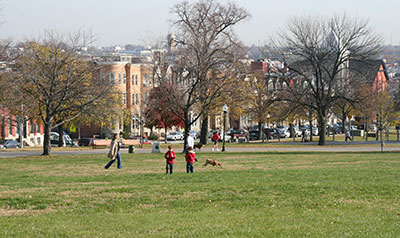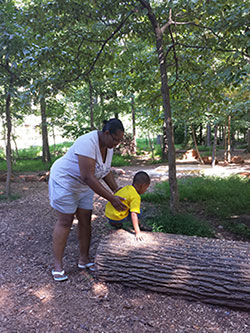 The MD park equity tool was developed in partnership with the University of Maryland School of Public Health. In addition to the park equity score, the MD EJ Screen data and more information are available on this tool.
The MD park equity tool was developed in partnership with the University of Maryland School of Public Health. In addition to the park equity score, the MD EJ Screen data and more information are available on this tool.

Unstructured outdoor time is important for the overall well being of children. Evidence suggests that exposure to nature can improve attention and promote self-confidence, calmness, and other psychological aspects of health. The benefits of unstructured outdoor play produce positive developmental and health impacts for all Maryland children, including those from rural communities to those in urban and suburban neighborhoods.
To address this and other issues, the Maryland Project Green Classrooms led by the Department of Natural Resources and Maryland State Department of Education strives to ensure that all young people have the opportunity to learn about their environment, connect with their natural world and grow into responsible stewards. This “Park Equity Analysis” provides a quantitative statewide analysis identifying locations across the State with barriers to accessing public lands for a variety of factors.

Why is Access to Nature Important?
As defined in the movement launched by Richard Louv’s book, The Last Child In The Woods, “nature deficit disorder,” or the dissociation of children from nature, has been linked to a wide range of behavioral and health issues, including childhood obesity, attention deficit disorder (ADD), and depression. While many adults of generations past spent large portions of their childhood outdoors in spontaneous and unstructured play with other kids, today’s youths are more likely to stay inside watching television, playing video games, or simply may not have access to nature due to large-scale land development.
Research shows there are significant positive impacts of spending time in nature on a child’s physical, cognitive, and social maturation. Play in nature, particularly during the critical period of middle childhood, appears to be an important time for developing the capacities for creativity, problem-solving, and emotional and intellectual growth.
It is also important to access nature as an adult, senior citizen, and at all stages of one’s life. Access to parks can provide important health and community benefits beyond what occurs in the park.
- Community Health – evidence shows that access to park space encourages physical activity and promotes psychological benefits for children and teens
- Social – green space can offer recreational opportunities, create a sense of place, and has been linked to crime reduction
- Economic – numerous studies have shown that access to green space increases property value and even will make visitors want to shop or linger in greener areas
- Environmental – green spaces in cities provide a benefit to air quality, temperature cooling, and may aid in filtering stormwater run-off and increase community resilience to storms and flooding
Access for Everyone
During stressful times such as the public quarantine period, health care providers recognize the importance of spending time outside and in parks. Not only does the time outside bring stress relief and a time to recharge, but parks have become increasingly the social spaces in which people find respite and feel safe to move about and recharge. However, we know that not everyone has access to parks on the same scale. Either the spaces are not sufficient for a large population, or they may not be easily accessible or have the same amenities that make social distancing possible. This analysis is a guide to better understand the needs of communities and begin a discussion on location, amenities and park planning.